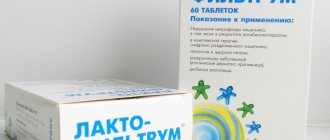Pharmacological action of Chloral hydrate
The drug has the following properties: anticonvulsant, sedative, analgesic, hypnotic. If you take Chloral hydrate in large dosages, it has a narcotic effect.
The drug has a strong effect on the central nervous system. When administered in small doses, Chloral hydrate weakens inhibitory processes, and when administered in large doses, excitation processes in humans are reduced.
Experts do not advise taking large doses of the drug that are close to toxic. After all, it is precisely these doses that inhibit the process of excitability of nerve cells.
The drug has a strong irritant effect on the mucous membranes of the stomach and intestines. For this reason, Chloral hydrate should be taken only in diluted form in combination with enveloping drugs.
Chloral hydrate is absorbed fairly quickly. Sleep, which is close to physiological sleep, occurs after about 15-20 minutes. This sleep lasts for 8 hours.
CHLORAL HYDRATE. Chloralum hydratum.Synonyms: aguachloral, chloradorm, dormal, dormiben, hydral, etc.
Properties.
Colorless transparent crystals or finely crystalline powder with a characteristic pungent odor and a slightly bitter taste. Very easily soluble in water (3:1) and alcohol. It evaporates slowly in air and is hygroscopic. Aqueous solutions are neutral and decompose to form trichloroacetic acid (decomposition accelerates when heated).
Release form. Available in powder form.
Store with caution (list B), in a well-closed container, in a cool place, protected from light. Shelf life: 8 years.
Action and application.
Chloral hydrate is a typical hypnotic and narcotic drug; it also has a sedative, analgesic and sedative effect.
In small doses, chloral hydrate does not change the processes of excitation, but enhances the processes of inhibition. All reflexes decrease, and inhibitory ones increase. In large doses close to toxic, there is a complete disappearance of both food and defensive conditioned reflexes, a weakening of the orientation reflex and relaxation of the body muscles.
After using chloral hydrate, anesthesia occurs within 15-20 minutes in horses and pigs, with almost no symptoms of excitement, and is characterized by a decrease or complete disappearance of pain sensitivity, relaxation of skeletal muscle tone, and weakening of reflex activity.
Chloral hydrate is used as a hypnotic and narcotic during various operations on animals intravenously, orally or rectally in the form of a 5-7-10% solution with coating substances that reduce its irritating effect on the mucous membrane of the stomach and intestines.
As a sedative and antispasmodic agent, chloral hydrate is used for overexcitation of animals, poisoning, spasmodic colic, blockage and narrowing of the esophagus, acute flatulence of the intestines, tetanus, strychnine poisoning and other convulsive conditions, painful straining and prolapse of the uterus and rectum, and coprostasis.
Doses (g/kg) intravenously
(as an anesthetic): horses 0.1-0.15, pigs 0.15-0.2, sheep and goats 0.2-0.25;
orally
(as a sedative and anticonvulsant): horses, sheep, pigs, rabbits and foxes 0.1 g/kg.
Chloral hydrate is contraindicated in severe diseases of the cardiovascular system, liver, kidneys, lungs and severe exhaustion.
Contraindications
According to the instructions, Chloral hydrate should not be used if patients suffer from severe diseases of the cardiovascular system, liver or kidneys. Also, the drug is not prescribed:
- For alcohol or drug addiction. Such dependence may be present or in history;
- For gastritis, peptic ulcer, esophagitis (when prescribing Chloral hydrate orally);
- For colitis, proctitis (when prescribing Chloral hydrate as an enema);
- With intermittent porphyria.
Chloral hydrate is prescribed with extreme caution to pregnant women. If you take the drug for a long period, the newborn may experience withdrawal syndrome.
The drug actively penetrates into breast milk, causing a sedative effect in children. For this reason, breastfeeding should be stopped when the drug is prescribed.
CHLORAL HYDRATE
CHLORAL HYDRATE
(Chlorali hydras
; synonym:
Chloradorm, Chloraldurat, Chloralum hydratum, Chloratol, Lycoral, Nycoton,
etc.; GPC, list B) is a hypnotic. 2,2,2-Trichloroethanediol-1,1; C2H3Cl3O2:
Colorless transparent crystals or finely crystalline powder with a characteristic pungent odor and slightly bitter taste. Very easily soluble in water, alcohol and ether; t°pl 49 - 55°; molecular weight (mass) 165.4. It evaporates slowly in air and is hygroscopic.
It has hypnotic, sedative, analgesic and anticonvulsant properties. In large doses it causes anesthesia. However, the drug is not used as an anesthetic due to the insignificant breadth of its narcotic action. In small doses it weakens inhibitory processes, and in large doses it inhibits excitation processes in the central nervous system. Unlike hypnotics from the barbiturate group, it has little effect on the duration of the paradoxical phase of sleep.
After oral administration, it is well absorbed from the gastrointestinal tract, easily penetrates tissue barriers and is therefore found in breast milk, amniotic fluid and fetal blood. In the body, under the influence of alcohol dehydrogenase, chloral hydrate is quickly converted into trichloroethanol, the action of which is mainly associated with its central effects. In the liver, with the participation of the NAD-dependent enzyme system, chloral hydrate is oxidized into an inactive metabolite—trichloroacetic acid. Trichloroethanol in the liver undergoes conjugation with glucuronic acid and thereby loses its pharmacological activity.
Chloral hydrate is a long-acting hypnotic and induces sleep lasting 6 to 8 hours. Sleep occurs 15 - 20 minutes after ingestion.
The drug is used
for various sleep disorders (see Sleep) and as a sedative (see). In addition, it is used as an anticonvulsant mainly for spasmophilia (see) and eclampsia (see).
Assign
orally and rectally for adults, 0.5-1 g (as a hypnotic) or 0.2-0.5 g (as a sedative). Due to its pronounced irritating properties, it is advisable to administer chloral hydrate in the form of mucus or in enemas with enveloping agents.
Highest single doses for adults orally and rectally: single 2 g, daily 6 g.
Taking chloral hydrate may be accompanied by a decrease in blood pressure. With long-term use, the possibility of developing addiction and drug dependence should be taken into account (see). In case of overdose, the drug inhibits myocardial contractility and has a toxic effect on parenchymal organs. In a dose of 10 g or more it causes acute poisoning (see Poisoning, table), the symptoms of which are similar to the picture of barbiturate poisoning. A few days after poisoning, jaundice and proteinuria may develop as a result of the toxic effect of the drug on the liver and kidneys.
Contraindicated
for diseases of the cardiovascular system, liver and kidneys.
Release form:
powder. Storage: in a well-closed container, protected from light, in a cool place.
See also Sleeping pills.
R. N. Alyautdin.
§ 15. CHLORAL HYDRATE
Chloral hydrate
or
- colorless crystals or finely crystalline powder with a characteristic pungent odor and slightly bitter, soluble in water, ethyl alcohol, diethyl ether and chloroform. Chloral hydrate is hygroscopic and evaporates slowly in air.
Application. Effect on the body.
Chloral hydrate is used in medicine as a sedative, hypnotic and analgesic. In large doses, chloral hydrate can cause poisoning. The toxic effect of chloral hydrate is similar to chloroform. It is used for mental disorders and as an anticonvulsant for tetanus, eclampsia and other diseases. In certain doses, chloral hydrate is used as a hypnotic.
Metabolism.
Chloral hydrate is quickly absorbed into the blood from the alimentary canal. It is metabolized in the body. The metabolites of chloral hydrate are trichloroethanol and trichloroacetic acid. It is believed that the toxic effect of chloral hydrate on the body is due to the formation of trichloroethanol. Trichloroacetic acid can be formed in the body in two ways: directly from chloral hydrate and from trichloroethanol. Trichloroethanol is excreted from the body in the urine as a glucuronide. After death resulting from chloral hydrate poisoning, a certain amount of it unchanged can be found in the liver and stomach.
Detection of chloral hydrate
Chloral hydrate gives all reactions that are used in chemical toxicological analysis to detect chloroform. This is explained by the fact that the reactions to chloroform used in chemical toxicological analysis are carried out in the presence of an alkali, under the influence of which chloral hydrate decomposes to release chloroform:
To distinguish chloral hydrate from chloroform, a reaction with Nessler's reagent can be used. This reaction is produced by chloral hydrate containing an aldehyde group. Chloroform does not give this reaction.
Reaction with Nessler's reagent. When chloral hydrate reacts with Nessler's reagent, free mercury is released:
Executing the reaction.
Add 2-3 drops of Nessler's reagent to a few drops of the test solution and shake the liquid. In the presence of chloral hydrate in the test solution, a brick-red precipitate is formed, which then becomes dirty green.
This reaction is not given by chloroform, carbon tetrachloride, dichloroethane and ethylene chloride. Aldehydes and some other reducing substances react with Nessler's reagent.
Preparation of Nessler's reagent (see Appendix 1, reagent 40).
Difference between chloral hydrate and chloroform.
In addition to the reaction with Nessler's reagent, the following test can be used to distinguish chloral hydrate from chloroform: the distillate obtained after distillation of toxic substances with steam is tested for the presence of chlorinated hydrocarbons using reactions with chloroform. If chlorinated derivatives are present, part of the distillate is shaken 2-3 times with new portions of diethyl ether (5 ml each). The ethereal extracts are combined and filtered through a dry filter. The filtrate is collected in a porcelain cup and the diethyl ether is evaporated at room temperature. If there was chloroform in the distillate, then when diethyl ether is evaporated, it evaporates along with this solvent. If chloral hydrate is present in the distillate, after evaporation of the ethereal extract, it remains in the porcelain cup. To confirm the presence of chloral hydrate in the residue, add 5-7 drops of water to it. The resulting solution is examined for the presence of chloral hydrate using the reactions described above (Fujiwara reaction, isonitrile formation reaction, reaction with Fehling's reagent, etc.).
Preliminary test for chloral hydrate in urine.
For this purpose, the preliminary test described above, based on the Fujiwara reaction, is used (see Chapter IV, § 14).
CONTENT
PREVIOUS | NEXT
More on the topic:
- Chloral hydrate - pharmaceutical reference
Order for the manufacture of the drug
Chloral hydrate belongs to a group of drugs that affect the central nervous system. The drug has the following properties: anticonvulsant, sedative, analgesic, hypnotic. The drug has a strong irritant effect on the mucous membranes of the stomach and intestines. For this reason, chloral hydrate should be taken only in diluted form in combination with enveloping drugs.
Chloral hydrate is absorbed fairly quickly. Sleep, which is close to physiological sleep, occurs after about 15-20 minutes. This sleep lasts for 4-8 hours.
Indications for use:
- mental excitement;
insomnia;
The drug is prescribed to patients who need to undergo certain types of studies that require prolonged immobility (CT, MRI). Doses in this case are selected individually, depending on the age and characteristics of the body.
Method of administration and dosage: For adult patients, the drug should be prescribed either orally or in the form of enemas (dose 0.2-1.0 g per dose). Chloral hydrate should be taken only with enveloping drugs and in a sufficiently large dilution. For children, the dosage of the drug should be prescribed depending on age - 0.05-0.75 g. The maximum dosage of chloral hydrate for adult patients is 2 g, and the daily dosage is 6 g.
Side effects: When taking chloral hydrate, blood pressure may decrease and vomiting may occur. Long-term use of the drug often leads to the patient becoming dependent on taking chloral hydrate.
Contraindications: chloral hydrate should not be used if patients suffer from severe diseases of the cardiovascular system, liver or kidneys.
Also, the drug is not prescribed:
- with alcohol or drug addiction
- for gastritis, peptic ulcer, esophagitis (when administered orally);
- for colitis, proctitis (when prescribing chloral hydrate as an enema);
- with intermittent porphyria.
Chloral hydrate is prescribed with extreme caution to pregnant women. If you take the drug for a long period, the newborn may experience withdrawal syndrome. The drug actively penetrates into breast milk, causing a sedative effect in children. For this reason, breastfeeding should be stopped when the drug is prescribed.
Overdose: Currently, there is no specific antidote. Treatment of overdose is as follows: gastric lavage should be performed, breathing and circulation should be maintained at optimal levels, and forced diuresis should be performed. If the patient has severe poisoning, hemodialysis should be performed.
Special instructions. The drug should not be taken simultaneously with drugs that affect the central nervous system, as well as with alcoholic beverages.
Dispensing conditions: by prescription
Shelf life 10 days.






